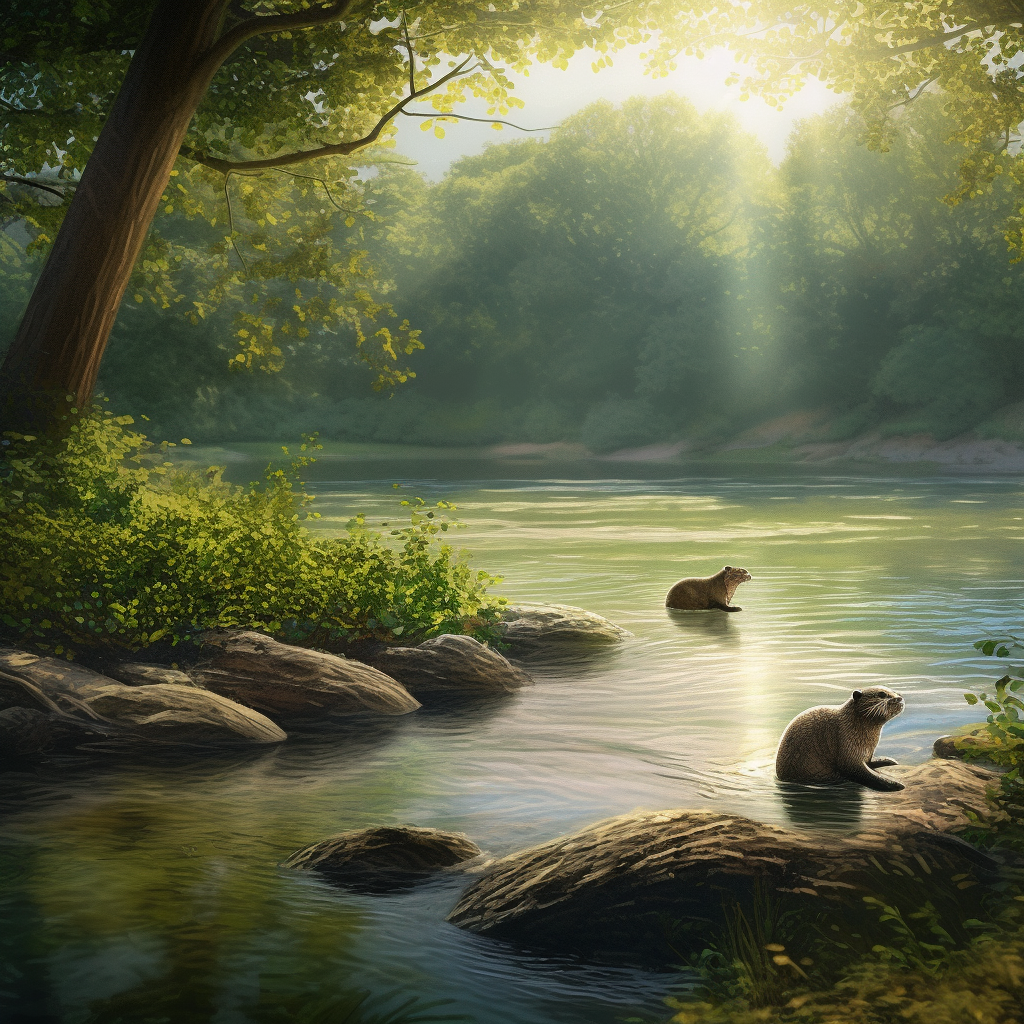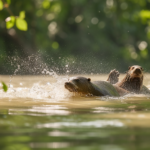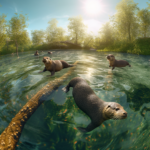River otters are fascinating creatures that can be found in various parts of the world, including the state of Virginia. These playful and agile mammals are known for their sleek bodies, webbed feet, and long, muscular tails. In Virginia, river otters can be spotted in a variety of habitats, including rivers, streams, lakes, and marshes. They are highly adaptable and can thrive in both freshwater and saltwater environments. River otters are an important part of the ecosystem, as they help maintain a healthy balance by controlling populations of fish and other aquatic species. In this article, we will explore the world of river otters in Virginia, their behavior, habitat, diet, and conservation efforts to protect these charismatic creatures. So, let’s dive in and discover more about the fascinating world of river otters in Virginia.
Key Takeaways
- River otters are native to Virginia and can be found in various aquatic habitats such as rivers, streams, and marshes.
- They are highly adaptable and have a playful nature, often sliding down muddy banks and engaging in social behaviors.
- River otters play a crucial role in maintaining the health of aquatic ecosystems by controlling populations of fish and invertebrates.
- Conservation efforts are important to protect river otters and their habitats, as they face threats such as habitat loss, pollution, and hunting.
- Observing river otters in their natural habitat can provide valuable insights into their behavior and contribute to their conservation.
The Enigmatic World of River Otters in Virginia

A. Understanding the North American River Otter in Virginia
The North American River Otter is a fascinating creature that inhabits the waterways of Virginia, adding to the state’s rich biodiversity. These playful and intelligent mammals are well-adapted to their aquatic lifestyle, with streamlined bodies, webbed feet, and a thick, water-repellent coat that keeps them warm in the chilly waters.
River otters are known for their playful behavior, often seen sliding down muddy banks or engaging in spirited water games. They are highly social animals, living in family groups called “rafts,” which consist of an adult pair and their offspring. These rafts communicate through a variety of vocalizations, including chirps, whistles, and growls.
B. The Habitats: Where do River Otters Live in Virginia?
River otters in Virginia can be found in a variety of habitats, including rivers, streams, lakes, and marshes. They are particularly fond of areas with abundant vegetation and ample food sources, such as fish, crayfish, frogs, and small mammals.
Virginia’s aquatic ecosystems provide the perfect environment for river otters to thrive. The state’s numerous rivers, including the James River, Rappahannock River, and Potomac River, offer ample hunting grounds for these agile swimmers. Additionally, the Chesapeake Bay and its tributaries provide a diverse range of habitats where otters can find food and shelter.
C. River Otters in the Little Otter River, Virginia
One of the notable locations where river otters can be found in Virginia is the Little Otter River. This picturesque waterway, located in the western part of the state, offers an ideal habitat for these charismatic creatures.
The Little Otter River is characterized by its clear, cool waters and lush vegetation along its banks. These features attract a variety of fish and other aquatic prey, making it an excellent hunting ground for river otters. The otters in this area have adapted to the river’s unique conditions, utilizing its twists and turns to their advantage as they navigate and search for food.
Observing river otters in the Little Otter River can be a thrilling experience for wildlife enthusiasts. With patience and a bit of luck, visitors may catch a glimpse of these elusive creatures swimming gracefully or playing in the water. It is a testament to the importance of preserving and protecting the natural habitats that support these remarkable animals.
In conclusion, the enigmatic world of river otters in Virginia is a testament to the state’s diverse and thriving wildlife. Understanding their behavior, the habitats they inhabit, and specific locations like the Little Otter River allows us to appreciate the beauty and importance of these fascinating creatures. By preserving and conserving their natural habitats, we can ensure that future generations will have the opportunity to witness the playful antics and graceful movements of river otters in Virginia’s waterways.
The Life Cycle of Virginia’s River Otters
A. The Birthplace: Where do River Otters Have Their Babies?
River otters are fascinating creatures that inhabit the rivers and waterways of Virginia. These playful and intelligent mammals have a unique life cycle that begins with the birth of their young. But where do river otters choose to have their babies?
River otters typically give birth in dens, which are usually located near water sources such as rivers, lakes, or marshes. These dens provide a safe and secure environment for the otters to raise their offspring. The dens are often constructed in riverbanks, hollow logs, or abandoned beaver lodges.
The female otter, known as a sow, will select a den that offers protection from predators and easy access to food. She will line the den with leaves, grass, and other soft materials to create a cozy and comfortable nesting area for her young.
River otters are known to be social animals, and multiple females may share a den during the breeding season. This communal denning behavior helps to provide additional protection and support for the otters and their offspring.
B. The Diet: What Do River Otters Eat?
River otters are carnivorous creatures with a diverse diet that primarily consists of fish. However, their diet can vary depending on the availability of food in their habitat. Let’s take a closer look at what river otters eat.
Fish make up a significant portion of a river otter‘s diet. They are skilled hunters and use their sharp teeth and strong jaws to catch and consume various species of fish, including trout, bass, and catfish. River otters are excellent swimmers and can dive underwater for several minutes to catch their prey.
In addition to fish, river otters also feed on other aquatic creatures such as crayfish, frogs, turtles, and even small mammals like muskrats and rabbits. They are opportunistic feeders and will take advantage of any available food source in their environment.
River otters have a high metabolic rate, which means they need to consume a substantial amount of food to sustain their energy levels. They can eat up to 15% of their body weight in a single day. This voracious appetite is necessary for their survival, as they need to maintain their energy levels for swimming, hunting, and raising their young.
In conclusion, the life cycle of Virginia’s river otters is a fascinating journey that begins with the birth of their young in carefully selected dens. These playful creatures rely on a diverse diet, primarily consisting of fish, to sustain their energy levels and thrive in their aquatic habitats. By understanding their life cycle and dietary needs, we can better appreciate and protect these remarkable animals in Virginia’s rivers and waterways.
The Presence of River Otters Beyond Virginia

A. Are There River Otters in Colorado?
River otters are not exclusive to Virginia; they can be found in various parts of the United States, including Colorado. These playful and charismatic creatures have a wide distribution across North America, inhabiting both freshwater and coastal ecosystems.
In Colorado, river otters were once on the brink of extinction due to habitat loss and unregulated trapping. However, through successful conservation efforts, their population has rebounded in recent years. Today, river otters can be spotted in several regions of the state, including the Colorado River, the Yampa River, and the San Juan River.
B. River Otters in West Virginia
West Virginia is another state where river otters can be found. These sleek and agile mammals are well adapted to the state’s diverse aquatic habitats, including rivers, streams, lakes, and wetlands. River otters play a vital role in maintaining the health of these ecosystems by controlling populations of fish and invertebrates.
In West Virginia, river otters were once extirpated due to habitat destruction and unregulated trapping. However, in the 1980s, a successful reintroduction program was initiated, leading to the reestablishment of river otter populations in the state. Today, they can be found in various waterways, such as the Ohio River, the Kanawha River, and the Monongahela River.
C. Where do River Otters Live in the US?
River otters have a widespread distribution throughout the United States, occupying a range of habitats from coast to coast. They can be found in almost every state, with the exception of a few arid regions in the western part of the country.
These adaptable creatures thrive in both freshwater and marine environments, including rivers, lakes, ponds, estuaries, and coastal areas. River otters are excellent swimmers, equipped with webbed feet and a streamlined body that allows them to navigate through water with ease.
Some of the states where river otters are commonly found include Alaska, California, Florida, Louisiana, Michigan, Minnesota, New York, Oregon, and Washington. Each state has its own unique populations and conservation efforts in place to protect these charismatic creatures.
To summarize, river otters are not limited to Virginia; they can be found in various states across the United States, including Colorado and West Virginia. Their ability to adapt to different aquatic habitats has allowed them to establish populations in diverse regions, contributing to the biodiversity and ecological balance of these areas.
The Human-Otter Interaction

A. Are River Otters Dangerous?
River otters are fascinating creatures that inhabit the rivers and waterways of Virginia. While they may appear cute and playful, it’s important to remember that they are wild animals and should be treated with caution.
River otters are not typically dangerous to humans. They are generally shy and will avoid human contact if possible. However, if they feel threatened or cornered, they may defend themselves. It’s important to give them their space and observe them from a safe distance.
B. How to Attract River Otters: A Respectful Approach
If you’re interested in observing river otters in their natural habitat, there are a few things you can do to increase your chances of spotting them. However, it’s crucial to approach this with respect for the otters and their environment.
-
Choose the right location: Research the best areas in Virginia where river otters are known to inhabit. Look for rivers, lakes, or wetlands that provide suitable habitats for otters.
-
Be patient: River otters are elusive creatures, so it’s important to be patient and spend enough time in their habitat. Set aside several hours to increase your chances of spotting them.
-
Stay quiet and still: River otters have excellent hearing and can be easily scared away by loud noises or sudden movements. Stay quiet and still, and avoid making any sudden gestures or loud noises that could startle them.
-
Use binoculars or a camera: Binoculars or a camera with a zoom lens can help you observe river otters from a safe distance without disturbing them. This way, you can enjoy their behavior without intruding on their space.
Remember, it’s crucial to respect the otters’ natural behavior and not to feed or approach them. Feeding them can disrupt their natural diet and behavior, and approaching them can cause stress and potentially dangerous situations.
C. Adopting a River Otter: A Unique Experience
Adopting a river otter as a pet is not recommended or legal in most cases. River otters are wild animals and require specific habitats and diets that cannot be easily replicated in a domestic setting. They also have complex social structures and need the company of other otters.
However, if you’re passionate about otter conservation and want to contribute to their well-being, there are other ways to get involved. Consider supporting local organizations or wildlife rehabilitation centers that work to protect and rehabilitate river otters. You can volunteer your time, donate funds, or even participate in educational programs to raise awareness about otter conservation.
By supporting these organizations, you can play a vital role in ensuring the preservation of river otters and their habitats in Virginia. Remember, it’s important to appreciate these incredible creatures from a distance and allow them to thrive in their natural environment.
River Otters in Norfolk, VA: A Case Study
Norfolk, Virginia, is home to a diverse range of wildlife, including the charismatic North American River Otter. These playful creatures can be found in various habitats throughout the state, particularly in the lush rivers and waterways of Virginia. In this case study, we will explore the behavior, ecology, and conservation efforts surrounding River Otters in Norfolk, VA.
The Otter’s Habitat
Virginia’s rivers and waterways provide an ideal habitat for River Otters. These semi-aquatic mammals thrive in freshwater environments, such as lakes, ponds, and streams. With an abundance of rivers flowing through Norfolk, otters have ample space to swim, play, and hunt for food.
Behavior and Ecology
River Otters are known for their playful nature and social behavior. They are highly adaptable and can be found in both rural and urban areas. In Norfolk, they have adapted to coexist with human populations, often seen near residential areas and parks.
These otters are excellent swimmers, thanks to their streamlined bodies, webbed feet, and muscular tails. They can dive underwater for several minutes, using their keen sense of sight and touch to locate prey. River Otters primarily feed on fish, amphibians, crustaceans, and small mammals.
Conservation Efforts
As with many wildlife species, River Otters faced significant population declines due to habitat loss and pollution in the past. However, through conservation efforts and habitat restoration projects, their numbers have rebounded in Virginia, including Norfolk.
The Virginia Department of Wildlife Resources has implemented measures to protect and conserve otters and their habitats. These include regulating hunting and trapping, monitoring water quality, and creating protected areas along rivers and wetlands. These efforts have been successful in ensuring the survival and well-being of River Otters in Norfolk and throughout the state.
Otter Sightings in Norfolk
If you’re lucky, you might catch a glimpse of a River Otter during your visit to Norfolk. Keep an eye out for their playful antics near rivers, lakes, and other water bodies. Early morning or late evening is often the best time to spot them, as they are most active during these hours.
Remember, it’s important to observe otters from a distance and not disturb their natural behavior. Binoculars or a camera with a zoom lens can help you get a closer look without causing any harm.
Conclusion
The presence of River Otters in Norfolk, VA, is a testament to the resilience of these remarkable creatures. Through conservation efforts and a commitment to preserving their habitats, we can continue to enjoy the beauty and wonder of Virginia’s wildlife for generations to come. So, next time you find yourself near a river in Norfolk, keep your eyes peeled for the playful antics of the North American River Otter. Conclusion
In conclusion, river otters in Virginia are fascinating creatures that play a vital role in the state’s ecosystem. These semi-aquatic mammals are known for their playful behavior, sleek appearance, and excellent swimming skills. Despite facing challenges in the past, such as habitat loss and pollution, river otters have made a remarkable comeback in Virginia due to conservation efforts. Their presence in the state’s waterways is not only a testament to the resilience of these animals but also a positive sign for the overall health of the environment. By understanding and appreciating these charismatic creatures, we can continue to protect and preserve their habitats for future generations to enjoy. So, next time you find yourself near a river or stream in Virginia, keep an eye out for these delightful creatures – you might just spot a river otter in action!
Frequently Asked Questions
Q1: How can I attract river otters to my property?
A: To attract river otters, you need to ensure a healthy aquatic ecosystem. This includes clean water bodies with abundant fish, which is their primary food source. Providing hiding places like logs and dense vegetation can also encourage otters to visit. However, remember that otters are wild animals and should not be treated as pets.
Q2: What rivers in Virginia are known to house river otters?
A: River otters can be found in various rivers across Virginia, including the Little Otter River, the Otter River, and rivers in Norfolk, VA. They are adaptable and can thrive in any water body as long as it has a food source and is clean.
Q3: What is the ‘otter ocean code’?
A: The term ‘otter ocean code‘ is not commonly used in relation to otters or their habitats. It may be a specific term used in a particular context or study. For accurate information, it’s best to refer to the original source where this term is used.
Q4: Are river otters dangerous to humans?
A: Generally, river otters are not dangerous to humans. They are shy and will usually avoid human interaction. However, like any wild animal, they can become aggressive if they feel threatened or cornered. It’s always best to observe them from a distance and not to feed or try to touch them.
Q5: Are there river otters in Colorado?
A: Yes, river otters can be found in Colorado. They were reintroduced to the state in the 1980s and have since established stable populations in several river systems.
Q6: Where do river otters live in the US?
A: River otters are found in a variety of aquatic habitats across the US, including rivers, streams, lakes, ponds, and coastal marshes. They are present in every US state except Hawaii.
Q7: How can I adopt a river otter?
A: It’s important to note that river otters are wild animals and not suitable as pets. However, many conservation organizations offer symbolic adoptions where your donation contributes to the protection and conservation of these animals in the wild.
Q8: Do river otters live in Virginia?
A: Yes, the North American River Otter is native to Virginia and can be found in its rivers, streams, and other water bodies.
Q9: Where do river otters have their babies?
A: River otters usually give birth in dens located near water. These dens can be in natural hollows, under logs, or in burrows made by other animals.
Q10: What do river otters eat?
A: River otters are carnivorous and their diet primarily consists of fish. However, they also eat a variety of aquatic creatures, including crayfish, frogs, and occasionally small mammals and birds.




